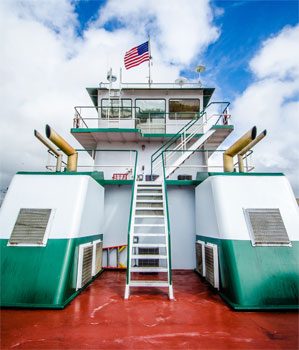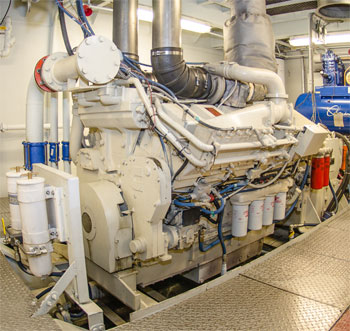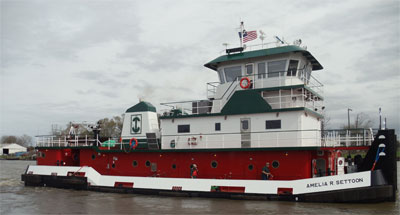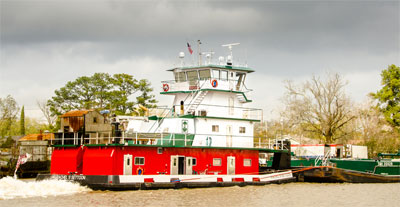Settoon Towing of Houma, La., has taken delivery of 15 new towboats since 2010, and has another five under construction. The rapid growth of the company would be impressive any time, but more so given the dreary economy of the past four years.
The company’s corporate offices are located on Highway 70, a stretch of levee-lined pavement sandwiched between the Atchafalaya River and Belle River, just south of Pierre Part.
At first glance it seems an unlikely location for a headquarters, given that Morgan City, 17 miles to the south, or Houma, are more typical and more central locations for an oil transportation company. However, Belle River is on the Port Allen to Morgan City Intracoastal route, linked by road or water to the company’s operations office in Houma and its marketing office in Houston.
 |
|
The pilothouse viewed from the rear deck. |
Settoon recently took delivery of the 76-foot, 2,000-hp Rachel S. Settoon, built at Raymond & Associates in Bayou La Batre, Ala., and the 96-foot, 2,600-hp Amelia R. Settoon from Eastern Shipbuilding in Panama City, Fla. The vessels are representative of two classes of boats the company has commissioned during its aggressive expansion program. The fleet includes four of the 96-footers from Eastern, and the five boats under construction are 2,000 hp, similar to Rachel. Four of those five boats are being built at Sneed Shipbuilding in Channelview, Texas, and the fifth at Raymond & Associates.
“We expanded in 2008, building our first 30,000-barrel, 290-by-54-foot tank barge,” said Settoon’s Vice President and COO Mike Ellis. “It was in response to our customers’ moving into a larger market.”
for Amelia R. Settoon |
for Rachel S. Settoon |
Settoon’s main focus is on crude oil and clean product transportation, but it has built a few small, 10,000-barrel barges called regulation 10s for the chemical market. “We don’t do a lot of chemicals,” said Ellis. “In this business you tend to see a company concentrating on one or the other, liquids or chemicals. Each might do a little of the other if the customers request it. We have heated barges so we can do asphalt, but we don’t do much of that.”
The company’s fleet typically pushes two-piece and occasionally three-barge tows along the Gulf Intracoastal Waterway from Brownsville, Texas, to Florida and on the Mississippi waterway system.
“We go up to Chicago where we load crude and bring it down the river to the Gulf Coast,” said Ellis. “We have 50 barges and 24 boats working on that part of the business.”
Amelia’s 34-foot beam is a little wider than is traditional for a 96-foot towboat. The designer, Tom Farrell of Farrell & Norton Naval Architects in Newcastle, Maine, said the wider girth reflects a trend in towboat design to gain more interior space with the lagniappe of more stability.
The vessel’s propulsion consists of two Caterpillar 3512C Tier 2, keel-cooled, air start mains, rated at 1,300 hp each at 1,200 rpm. The mains are connected to Twin Disc MGX-5600 reduction gears at a 4.03:1 ratio. The shaft brakes are Twin Disc air/hydraulic with 32-inch diameters. Louisiana Machinery supplied the main engines and, along with Sewart Supply, supplied the reduction gears and Twin Disc propulsion controls.
 |
|
Rachel S. Settoon is powered by two 1,000-hp Cummins K38-M diesel engines. |
At the business end of the eight-inch tail shafts are Hung Shen four-blade stainless steel 82-by-58-inch propellers. The four flanking rudders and two main rudders were built at Eastern Shipbuilding.
Two John Deere 6068TFM76 Tier 2 generator motors married to Marathon 99-kW generators were supplied by Kennedy Engine Co., of Biloxi, Miss. On deck are two electric and two manual 40-ton Nabrico deck winches with Spectra 1.25-inch line for making up to the barge tow. A Stellar 5520 electrical pedestal telescoping crane is mounted near the 16-foot Alumaweld skiff with a 25-hp Yamaha four-stroke engine on the transom.
Schuyler Rubber supplied the model 115 pushknee fenders and the side hull fenders. Greg Armfield at Schuyler said that the bow fender wrap corners were specially designed for tight work.
Mackay Marine of New Orleans was the subcontractor for the Furuno electronics package consisting of an AIS, GPS, echo sounder, loud hailer, anemometer, and two radars. A Dell computer is loaded with Rose Point inland waterway charts and has a 19-inch, flat-screen, color display.
The crew, as well as having a little more interior space, enjoy 19-inch televisions in each stateroom and 37-inch Sony Vizio televisions in the lounge, via a KVH TracVision M5 13V HD satellite receiver.
Rachel S. Settoon was designed and built by Raymond & Associates. The 76-by-35-foot, 2,000-hp boat is powered by twin Cummins K38-M diesel engines. The 7.0:1 ratio Twin Disc MG-540 reduction gears were supplied by Sewart Supply. The electric power is supplied by two Cummins 6B 75-kW marine diesel generators.
On the foredeck are two 40-ton Nabrico hydra/electric winches with Spectra 1.5- inch soft line. Schuyler Rubber supplied the fendering and pushknee rubber. The electronic package for Rachel, which consists of a Rose Point chart display, a Ritchie magnetic compass and Furuno radar and AIS, was provided by D & G Communications, in Texas City, Texas.
With all the new boats and equipment, it’s easy to forget that Settoon boats have been around since the late ’60s, when Fred Settoon opened a welding shop and began building small boats and eventually larger oilfield service craft. Fred founded Settoon Oilfield Services around a small fleet of tugs, barges and crew boats. He later renamed the company Fred Settoon Inc.
 |
|
The 96-foot, 2,600-hp Amelia R. Settoon built by Eastern Shipbuilding. |
Russ Settoon founded Settoon Towing in 1994 and bought his father’s company in 1996. In 2006, Plains All American Pipeline acquired 50 percent of Settoon, making an expansion campaign possible.
Two of the 96-footers built at Eastern, Fred A. Settoon and Shirley P. Settoon, are named for Russ’s parents.
Settoon Towing began primarily as a gathering company with a fleet of 900-hp and 1,000-hp tugs pushing 5,500-barrel tank barges into a maze of tiny waterways and collecting crude from small pumping operations tucked into the wetlands.
Today Settoon Towing is a full-blown oil transportation company, with over 50 towboats and 80 tank barges and employing around 400 people.
“We’ve served our customers as they grow, so we’ve grown with them,” said Ellis. “We’ve had significant growth in the past five years and feel comfortable where we are right now. But if the right opportunity exists, we’ll capitalize on it.”


